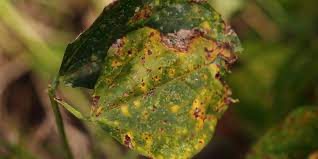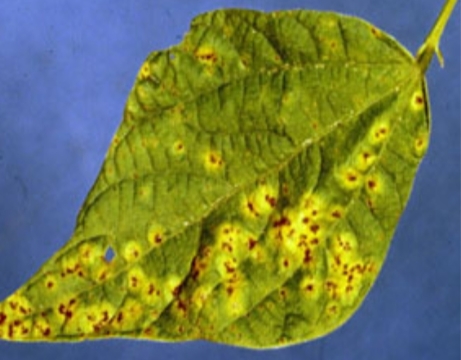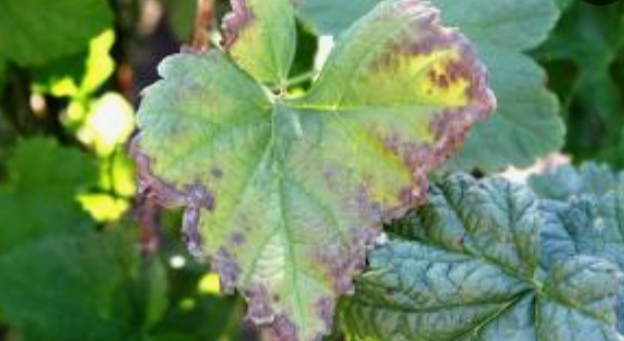Green Beans
Green beans are annuals, 8-20 inches tall, and frost-sensitive. They prefer well-drained, sandy-loam soil in full sun. Keep the soil moist. Green beans are edible but not medicinal.
Habit
Annual
Height
1-2 ft
Growth
Fast
Soil
Well-drained loam
Shade
Full Sun
Moisture
Moist
Edible
Yes
Medicinal
No
Origin
Americas
Climatic Condition
Tropical, Subtropical
Temperature (°)
20-30°C
Humidity (%)
50-80
Potting media
Loam, compost
Fertilizers
Organic
Watering
Regular
Plant Weight
50-200 g
Flowering Time
Summer
Soil Ph level
6.0-7.5
Water Ph level
6.0-7.5
Soil EC
1.0-1.3
Yield Per Plant
5-10 kg/plant
NPK ratio
10:10:10
life Span
Annual
Health Benefits
Rich in protein, dietary fiber
Suggested Grow Media or Potting Mix ?
50% loam, 25% compost, 25% sand
Suggested Fertigation/Fertilizers
Fertilize every 4 weeks with a balanced fertilizer.
Common Diseases and Remedies
Anthracnose , Rust
Black spots on lower side of leaves , Appear dark brown and red spots on leaves
use healthy seedlings , application of neem oil
HEALTH BENEFITS
· Good source of fiber, promoting digestive health.
· Rich in vitamins A, C, and K, supporting immune function and bone health.
What Is A Green Bean ?
Green beans, also known as green beans or kidney beans, are the immature fruits of several varieties of many beans (Phaseolus vulgaris). The seeds are harvested and eaten as pods before they are fully ripe. Green beans are generally long, round, and green in color, but vary in size, shape, and color depending on the variety. It is a popular vegetable in many cuisines around the world due to its texture, flavor and benefits. Green beans can be eaten raw or cooked, often steamed, sauteed, sautéed, or added to salads, soups, and stews.

What are the different types of green bean?
There are many types of mung beans, each with its own characteristics. Here are a few more:
1. Bush Beans:-
These are plants that grow like trees and do not need support. They are generally easier to grow and harvest than lentils.
2. Pole Beans:-
These beans grow on tall trees that require support such as trellises or poles. They tend to be more productive but require more space and maintenance.
3. Stringless Beans:-
This variety is bred to remove the tough "string" that runs along the seams of the pods, making them easier and tastier to eat.
4. French Beans(Haricots Verts):-
Thinner and more delicate than the usual green beans, with more eyes. They are usually written when you are young and competitive.
5. Purple Beans:-
These beans are purple in color and turn green when ripe. They have a slightly different shape and look better than green beans.

How to Care for Green Bean Plant?
1. Location:-
Green bean plants are often grown in containers outdoors in the garden, on the terrace or balcony. They need sunlight to thrive, so they're not good for growing indoors unless you have a sunny, spacious indoor area like a greenhouse or sunroom. green beans like full sun, so choose a spot in your garden that gets at least 6-8 hours of direct sunlight per day. Make sure the soil is well drained and fertile. Adding compost or manure before planting can improve the quality of the soil. Sow mung bean seeds or seedlings directly into the ground after danger of frost has passed, usually in late spring or early summer. Provide support for lentil varieties by erecting trellises, stakes or tents for climbing vines. Regular maintenance of moisture and water so that the soil is balanced but not wet. Be aware of pests and diseases and take appropriate measures to control them when necessary.
2.sun shine:-
Green bean plants need sunlight to grow and produce good crops. Some important facts about the sunlight needs of mung bean plants:
Full sun
Good Growth
Indoor Growing
Outdoor planting
Sun Protection
3. soil:-
Green bean plants have simple soil requirements, but you must make sure they grow well. Well-drained soils that are not easy to collect water. They cannot tolerate water around their roots, which can cause root rot and other problems. Avoid heavy clay soils that retain too much water. Beans prefer slightly acidic soil with a pH between 6.0 and 7.0 over neutral soil. You can test your soil's pH using soil testing kits available at your garden center or local agricultural service. If necessary, the pH can be adjusted by adding a control such as lime to raise the pH or by adding sulfur to lower the pH. Although mung beans do not need as much food as other vegetables, they benefit from soil rich in organic matter. Add compost or well-rotted manure to the soil before planting to improve fertility and soil structure.
4.Hydration:-
Proper irrigation is essential to the health and production of your soybean plant. Green bean plants need to be watered consistently throughout the growing season. Keep the soil evenly moist, but not waterlogged. Irregular watering can cause problems such as rotting of inflorescences and stunted fruit development.When watering your mung bean plants, provide enough water to penetrate deep into the root zone. Deep watering promotes healthy root development and helps plants withstand drought. Water your soybeans in the morning to reduce water evaporation and fungal diseases. Do not water in the afternoon or evening because wet leaves at night can cause disease. Apply a layer of organic mulch such as straw, grass clippings or shredded leaves around your mung bean plants to help retain soil moisture, suppress weeds and control soil. Mulching also slows evaporation from the soil surface, thus reducing the frequency of watering. Water from the bottom of your bean plant instead of higher to prevent water from coming from the leaves. Wet leaves encourage the spread of fungal diseases such as powdery mildew and leaf spot.

5.Nourshiment :
NPK (nitrogen, phosphorus and potassium) ratios of mung bean plants will vary depending on the fertility of the soil, previously changed conditions and growing conditions. Nitrogen is important for the growth and development of mung bean plants, especially leaf growth. However, mung beans do not need a lot of nitrogen because it makes the leaves bushy but affects the fruits. A balanced NPK fertilizer with low to medium nitrogen content, such as a 5-10-10 or 10-10-10 formula, is suitable for mung bean plants. Phosphorus is important for the growth of roots, flowers and fruits in mung bean plants. Fertilizers containing more phosphorus, such as bone meal or phosphate rock meal, are effective in promoting root growth and early flowering. Potassium plays an important role in overall plant health, including disease resistance, water uptake and fruit development. Balancing NPK fertilizer with good potassium, such as a 10-10-10 formula, can help promote good growth and fruit production in mung bean plants.
6.Issues:
Green bean (Mung bean) plants can face many problems throughout their growth cycle, including pests, diseases, and environmental stress. Harmful , Aphids, Bean Beetle, Caterpillars, Spider mites , Powdery mildew , Anthracnose , Blight , Fusarium wilt , Environmental stress , Water Stress , Heat stress , Nutrient deficiency.
What are the benefits of Green bean (mung bean) plant?
The mung bean plant has many benefits, whether it is used as food or contributing to agriculture and farming.
Nutrition value , Vitamins , Minerals , They provide minerals such as manganese, potassium and folate, which are necessary for healthy bones, muscle tissue and DNA synthesis , Dietary fibre, which supports digestion, controls blood sugar and helps with weight control , Versatility in Cooking , easy to Grow , Soil Improvement , Crop rotation, Remove pollinators , Business Value.

FAQ's About Growing Green Bean
1.How to maintain green bean plant?
Keep the soil moist at all times but not waterlogged. Water your bean plants deeply, giving them about 1 inch of water each week, especially during drought or hot weather. Watering in the morning minimizes evaporation and reduces the risk of fungal diseases. Weed around your green beans regularly to reduce competition for water, nutrients and sunlight. Mulching can help kill weeds and retain soil moisture. Although mung beans do not require intensive feeding, they will benefit from a balanced fertilizer application during planting and flowering. Use a fertiliser with a good NPK (nitrogen, phosphorus, potassium) ratio, such as 10-10-10, or mix compost into the soil for a slow release of nutrients.
2. What is the use of Green beans Plant?
Green bean (Mung bean) plants have many uses, from cooking to soil improvement and ornamental value.
1.Culinary Use
2. Nutritional value
3. Soil Improvement
4. Garden Ornamental Plants
3.Can the Green bean plant be grown indoors?
Although Green bean plants prefer sunny outdoor locations, they can also be grown indoors under certain conditions.
1. Light
2. Space
3. Soil
4. Water
5. Temperature and humidity
6. Pollination
7. Pruning and Support
4.Which pot is best for growing area's in green bean plants?
When choosing a pot to grow mung beans, it is important to choose a container that has enough room for the roots to grow, provides adequate water, and supports the climbing plant (if growing). Choose a pot 12-18 inches deep and 12-18 inches in diameter or larger. The root system of mung bean plants is shallow, but there is enough room for root growth and the ability to retain moisture. Plastic sinks are lightweight, inexpensive, and available in many sizes. Look for containers made of durable, UV-resistant plastic that won't deteriorate over time.Terracotta or clay pottery is porous, allowing better control of airflow and moisture in the soil. They also provide better aesthetics and can help prevent overwatering by leaking too much water through the walls of the pot. Fabric grow bags are breathable, lightweight and have good drainage, making them ideal for growing bean plants. They come in many sizes and shapes and can be easily carried or folded for storage.
5.From where can i shop for green beans plant's?
1. Local nurseries and gardens
2. Farmers Market
3. Online plant stores
4. Seed Catalogs
5. Local Garden Club or Community Garden
6. Hardware Stores



